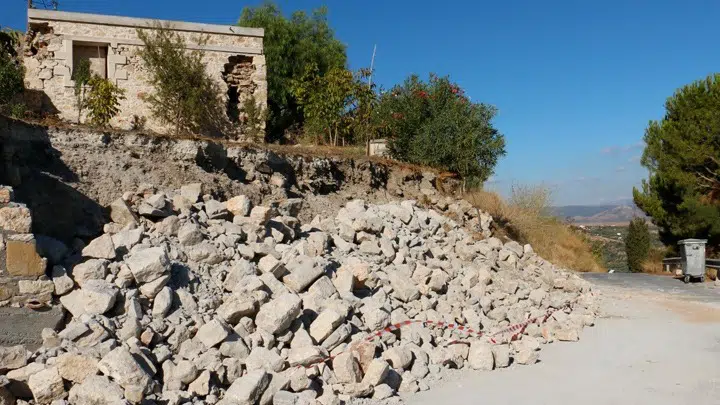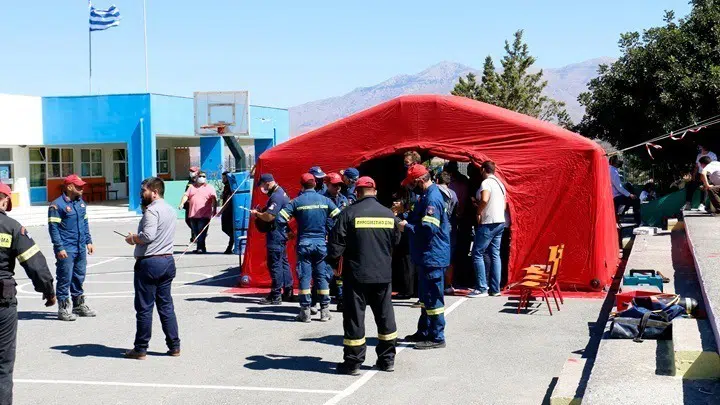
A strong aftershock measuring 5.3 on the Richter scale hit Crete early on Tuesday as the Greek island is rocked by multiple tremors following Monday’s 5.8 earthquake that claimed the life of one person and injured more than a dozen.
According to the first estimate of the Geodynamic Institute, the earthquake had its epicenter in the same region in central Crete that produced the main jolt, 21 kilometers northwest of the town of Arvi.
The jolt was felt throughout the island. Its focal depth was 13.9 kilometers.
In an earthquake sequence, an aftershock is defined as an earthquake that’s smaller than and which follows the main shock. The strongest aftershocks come soon after the main event and slowly taper off.
The island was then rocked by six other smaller earthquakes within two hours, the biggest registering at 4.6 and striking about 20 minutes after the first one.
Hundreds of people in the region spent the night in tents and parks or slept in their cars in the wake of Monday morning’s earthquake, which struck the village of Arkalochori, killing one person, injuring at least 20 and damaging dozens of homes and businesses.

The majority of the old buildings in Arkalohori sustained heavy damage and were deemed unsafe. Members of the Armed Forces, volunteers and members of the Hellenic Red Cross set up a temporary tent camp for Monday night.
Tents were also set up at villages along the municipality of Minoas Pediadas, where homes have been damaged.
Greek seismologists alarmed
Greek seismologists stated on Monday that they had been were expecting an earthquake on Crete, but were stunned by its magnitude.
A supermarket surveillance camera on the Greek island of #Crete captures merchandise falling off rattling shelves during Monday’s 5.8 magnitude #earthquake. A supermarket employee is seen running out of frame, possibly towards an exit. pic.twitter.com/uE21f8wQHk
— Daphne Tolis (@daphnetoli) September 27, 2021
The Seismic Danger Estimate committee had been expecting seismic activity on the island since July, but their estimate was that it would not rise beyond 5.4 on the Richter scale, the scientists noted.
Earthquake Planning and Protection Organization (OASP) president Efthimios Lekkas said that this particular quake was “unexpected, and came out of nowhere.” Commenting on the size of the seismic activity, Lekkas said that “it was almost irrational — the event was much larger in scale than we anticipated.”
Greece is especially earthquake prone
Greece lies in a highly seismically active region. The vast majority of earthquakes cause no damage or injuries, however.
Last October, an earthquake that struck the eastern Greek Aegean island of Samos and the nearby Turkish coast killed two people on Samos and at least 75 people in Turkey.
The country is located in a complex geological boundary zone in the eastern Mediterranean between the African Plate and the Eurasian Plate.
The northern part of Greece lies on the Eurasian Plate while the southern part lies on the Aegean Sea Plate.
The Aegean Sea Plate is moving southwestward with respect to the Eurasian Plate at about 30 mm (1 inch) per year while the African Plate is subducting northward, beneath the Aegean Sea Plate, at a rate of about 40 mm (1.6 inches) per year.
The northern plate boundary is a relatively diffuse divergent boundary while the southern convergent boundary forms the Hellenic Arc.
See all the latest news from Greece and the world at Greekreporter.com. Contact our newsroom to report an update or send your story, photos and videos. Follow GR on Google News and subscribe here to our daily email!



